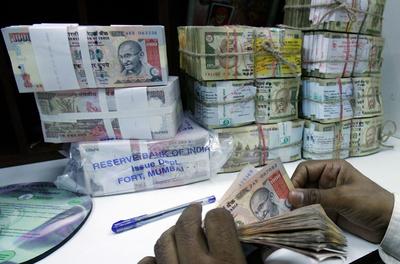The near free fall of the rupee and its disastrous fallout raises an important public policy issue: is it worth keeping intervention as an additional tool at India’s disposal?
It is clear that intervention is no longer a policy option at the Reserve Bank of India (RBI) — its belated and feeble intervention makes this apparent. But the current experience provides an opportunity to critically examine the trade-offs of India’s macroeconomic policy choices in recent years.
In 2010–11 capital inflows were buoyant, aggregating US$60 billion. The exchange rate adjusted fully to this inflow with a nominal appreciation of an average of 4 per cent year-on-year each month, and the adjustment in real effective terms was double this. Monthly inflation averaged a very high 10 per cent, while both oil and non-oil imports grew briskly at an average of 20 per cent every month.
With nearly 80 per cent of oil supplies coming from abroad, there is little doubt about the role a stronger currency might have played in restraining imported inflation. Exchange rate appreciation also allowed authorities to lessen the weight assigned to interest rates for monetary tightening that domestic inflationary conditions demanded.
A hands-off exchange rate policy was helpful on other counts as well. What, for example, might have been the fiscal cost of intervention in an inflationary phase?
This cost arises from the RBI exchanging foreign currency purchases for rupee assets — called Market Stabilisation Bonds (MSBs) — to limit feedback into the domestic money supply. Because rupee interest rates are higher relative to foreign currency, the differential interest cost devolves onto the government balance sheet. Assuming RBI had bought half the net capital inflow in 2010-11 ($30 billion) and sterilised the purchase, the quasi-fiscal cost would have been roughly Rs 62.47 billion or 0.13 per cent of GDP.
How much pressure would have been placed on the yield rate from additional issues of government bonds, in addition to the budgeted market borrowings of Rs 3.45 trillion? This is difficult to predict but it is doubtful a bond supply of nearly Rs 4.8 trillion (US$98 million) would have resulted in an average long-bond yield rate of 7.9 per cent as it did in 2010–11. The current financial year can serve as a rough guide for expected borrowings of more than Rs 5 trillion (US$102 million) pushed bond yields beyond 8.75 per cent in November. This forced the government to lift caps on foreign investment in sovereign bonds and the RBI to regularly manage yields through open-market operations. So there is little doubt that a no-intervention policy averted pressure on the yield rate in 2010–11.
But the wheels of fortune can turn. The fuel subsidy bill is expected to overshoot the budgeted amount by Rs 1 trillion (US$20 million) due to higher fuel costs from the rupee’s depreciation. And extra expenditure from revenue losses due to fuel tax cuts and additional interest outgo from unscheduled market borrowings will impact the fiscal deficit that is expected to exceed by at least one percentage point.
Apart from the fiscal damages, the unrestrained fall of the rupee is pushing up domestic inflation, which is of serious concern to the RBI. Harder to quantify are the injuries to the private sector, viz. sudden and large increase in external repayment obligations, shelved investment spending due to difficulties in raising additional financing and extreme price volatility.
Against this outcome, was it worth keeping intervention as an additional policy tool?
An extra firepower of some US$30 billion, accumulated when capital inflows were strong, may have facilitated early and decisive intervention to mitigate the unanticipated shock of the capital flows’ reversal in 2011–12. And adjusting the nearly Rs1.48 trillion (US$30.2 million) spent in over-generous subsidies could have reduced pressure on yields in 2010–11. This would have translated into a stronger fiscal position for 2011–12. In conjunction with a stronger reserves position, this would have provided greater policy room to manoeuvre unanticipated shocks.
As with any macroeconomic story, this one, too, can be told differently. But since all trade-offs represent conscious policy choices, it is fair to question whether the hands-off exchange rate policy was a deliberate one to check imported inflation.
Renu Kohli is a macroeconomist at the Indian Council for Research on International Economic Relations, and previously worked at the International Monetary Fund and the Reserve Bank of India.
An earlier version of this article was first published here in the Business Standard.

